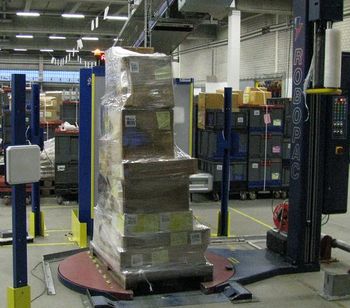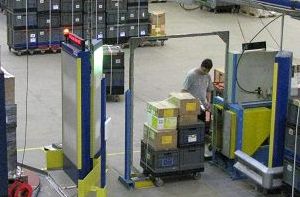Manor, Switzerland’s largest retail chain, says the RFID system it is rolling out should increase inventory visibility, cut labor costs and shorten replenishment cycles. The company is currently using the system, which became operational a week ago, to automate the processing of goods at two distribution centers and speed up the receipt of goods at five of its 80 stores.
Rodata, the Swiss company that is integrating the application, says Manor is using about 140,000 EPC Gen 2 tags attached to reusable plastic crates and 1 million tags attached to disposable cardboard boxes each year, in one of the largest RFID rollouts in the country.
George Rosenberger, the CEO of Rodata, says that reduced shrinkage alone could cover the cost of the application in a short period of time.

The retailer began implementing the RFID system in mid August and has placed two bar-coded labels that contain embedded RFID tags made by RF Identics on the ends of 70,000 reusable plastic containers, which measure roughly 60 by 40 by 40 centimeters. Each container carries two tags encoded with the same ID number and attached to opposite ends of the container so that workers that still need to need to read the bar codes can find them easily.
Cardboard boxes filled with goods arrive at Manor’s DCs—one in Hochdorf, the other in Möhlin—where sorting machines read the boxes’ bar-coded labels and, a based on that data, assign the boxes to pallets or dollies designated for specific stores. About 350,000 cardboard boxes arrive from China each year already carrying EPC Gen 2 RFID tags embedded in the bar-coded labels. These tags are applied by two third-party logistics hubs that Manor uses in the Far East. If boxes arrive without an RFID bar-code label, Manor tags the boxes in Switzerland.
In the next step, workers commission some goods using a pick-by-voice system. For example, workers put small quantities of individual items, such as perfume, into tagged containers that are then sorted by the machine. Even though only five of Manor’s 80 retail stores currently have the ability to read the RFID tags on the boxes and containers, Manor is already RFID tagging each box and container that holds general merchandise or apparel.
Once boxes have been sorted and commissioning is finished, workers stack 10 to 20 different boxes and/or containers on a pallet or dolly and then create a list of the goods before the pallet is stretch-wrapped or the goods on the dolly are bound with a plastic strap. In the past, workers had to scan the bar codes of each box or container on a pallet and each box or container on a dolly to create the list. Now, with RFID, the contents of a pallet or dolly are recorded automatically by an RFID reader installed at the stretch-wrapper or binding machine. The information collected via RFID—that is, the tag ID numbers of the containers and boxes—allows Manor to confirm in its information systems that a pallet or dolly holds the right goods for a specific store.
After the system reads the tags, workers move the mixed pallets and dollies by hand or forklift to a warehouse for short-term storage or directly toward the dock door bays. As the goods are moved to short-term storage or to the loading area, they pass through RFID readers at the doorways of storage areas, between buildings and at key thoroughfares in the DC. In that way, the system is updated regarding the goods’ location. The DC in Hochdorf has about 40 readers that track the location of the pallets inside the DC’s three buildings. This includes some 20 readers at dock doors. The DC at Möhlin has about 30 readers. Since the RFID tags are identified at various locations inside the DCs, Manor’s computer system is always updated on the DC’s “ready to ship” and “shipped” status, says Rene Wyss, the project manager for Rodata who helped design the system.
Because of the large numbers of tags moving around at the dock doors and through thoroughfares, Rodata designed a so-called transition portal using readers from Sirit, an RFID technology provider, and the Tag Acquisition Processor (TAP) from Reva Systems, an RFID network infrastructure provider. The transition portals are able to calculate the direction of a pallet’s movement and filter out unwanted tag reads, says Rosenberger. The data collected is interpreted with Reva’s Location Virtualisation Tool, which filters out the extraneous reads and calculates the direction of movement based on the exact location of the EPC tags.
After the tags’ final reading at the dock doors of the DCs, pallets and dollies are shipped to stores. Five stores are currently outfitted with RFID readers. Each of the five stores has one reader at each dock door, and two of those five stores have RFID readers at the entrance to separate storage areas. At these points, the tags on the pallets and dollies are read again, and the system compares goods ordered with actual goods received. If a box or crate is missing, the system alerts store managers.
During the initial stages of the rollout, Manor faced RF interference in its warehouse and difficulty positioning tags on mixed pallets. Rodata says it solved the problem with the help of Reva’s TAP, which controls the UHF readers like a coordinated and synchronized network.
Ashley Stephenson, Reva Systems’ CEO and cofounder, says, “Reva Systems’ TAP provides advanced RFID reader management and location virtualization to eliminate cross reads. This is particularly important in the busy DCs, where there are thousands of tags and multiple RFID-enabled stations operating at the same time in close proximity. It is critical that the correct tag gets reported to the correct location.”
Wyss says that Manor expects to increase its outbound shipping accuracy since fewer bar-coded labels must be scanned. It also envisions reduced shrinkage with the system since goods received will be compared with goods ordered as soon as they arrive, giving store managers a chance to immediately step in if boxes or crates are missing from a pallet.
Wyss will not say how much Manor invested in the project, but he says the company expects to recoup its investment within four years.
The project is not Manor’s first RFID application. It is also using tags and temperature sensors to monitor freezers at grocery stores (see At Manor, RFID Keeps Food From Spoiling).


